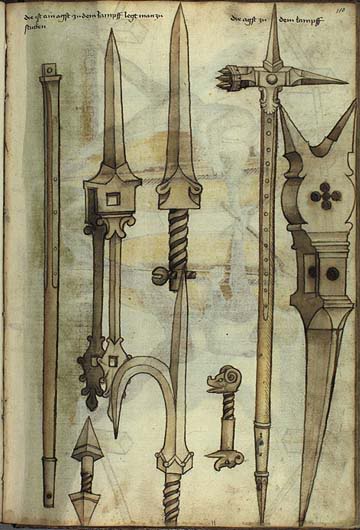Posts: 19 Location: Australia
Thu 22 Mar, 2012 7:57 am
Polearms with screwed-on heads?
The tale of
Richard Peeke's quarterstaff duel against three rapier-wielding Spanish soldiers is a popular one amongst HEMA fans, and one that I've regaled many people with over the years, both as evidence for the efficacy of polearms against swords and as a fun story in it's own right.
But it was recently pointed out to me that one part of it is fairly odd, at least by my understanding of polearm construction. Peeke, lacking a quarterstaff, is given the haft of a halberd to fight with. In his own words:
| Quote: |
| "Hereupon, the head of an halbert, which went with a screw, was taken off, and the steel [handle] delivered to me; the other butt end of the staff having a short iron pike in it." |
Which I take to mean that the halberd's head was screwed onto the haft. I have never heard of that manner of construction being used with a polearm, and I can't see how it could be strong enough to fight with. Am I misunderstanding the original text when I assume he means the head came off "with a screw" (that is, with a twist), or did Peeke mean that the head was attached with a separate actual, metal screw?
Posts: 113 Location: veenendaal netherlands
Thu 22 Mar, 2012 9:22 am
Look at this drawing from Hans Talhoffer.

Posts: 487
Thu 22 Mar, 2012 9:42 am
I have an original British artillery halberd in my collection c.1740 where the blade and spike section screws into the socket on the pole. See the example in Peterson's Arms and Armor in Colonial America for an almost exact duplicate of mine.
Posts: 5,981 Location: Birmingham, Alabama
Thu 22 Mar, 2012 11:23 am
I don't understand that at all. "steel," "handle," and "haft" don't really seem interchangeable in this context but they're used as synonyms. As for the "screw," it should be pretty easy to find an example among the surviving halberds of the period if such things existed. I've never seen one, and my own interpretation is that either the socket or langets were secured by screws. In fact, if the halberd did have langets of a piece with the socket, and if they were inset, it would not be possible to screw-on the head. Moreover, I can think of absolutely no reason why an armourer would go the time and expense to create a heavier threaded (cast) socket when the ordinary forged type is naturally more secure. Ditto for the haft. Why cut deep grooves, reducing wood, in the most critical area? On the other hand, it makes good sense to secure langets with screws so that damaged heads and hafts can be easily replaced.
On the other hand...by this time halberds were pale reflections of their 15th and early 16th c. ancestors. They were primarily badges of rank rather than combat weapons, so field impracticality and weakness of construction don't rule out the threaded socket. That would seem to be vanishingly rare, though.
Posts: 4,194 Location: Northern VA,USA
Tue 27 Mar, 2012 6:43 am
I have not seen of this kind of construction, but there are enough period weapons that contain similar traits that I would not be too surprised that this existed.
On a separate note, I always caution people from using Peeke's story as fact. It was, after all, written by Peeke, with no one else to confirm or deny his [rather unlikely] story.
Posts: 910 Location: Austria
Tue 27 Mar, 2012 8:52 am
| Sean Flynt wrote: |
| I don't understand that at all. "steel," "handle," and "haft" don't really seem interchangeable in this context but they're used as synonyms. As for the "screw," it should be pretty easy to find an example among the surviving halberds of the period if such things existed. I've never seen one, and my own interpretation is that either the socket or langets were secured by screws. |
The problem there is that surviving arms are not a random sample, but ones which happened to meet other criteria (eg. being in stock at Swiss or Austrian armouries which were never looted or cleaned out) and avoid others (eg. being handy to turn into a farm tool). This is why we have very few falchions and choppers, and no blunt practice swords before the end of the 16th century. Rare things, like specialized blunt-edged swords for duelling in armour, can miss surviving just by chance. I'm skeptical of this story, but I won't say that it was never used in renaissance Europe.
Some 16th century halberds use screws instead of nails to attach the head to the haft. See eg. fig. 79a in John Wakdman, Hafted Weapons in Medieval and Renaissance Europe (Brill, 2005).
You
cannot post new topics in this forum
You
cannot reply to topics in this forum
You
cannot edit your posts in this forum
You
cannot delete your posts in this forum
You
cannot vote in polls in this forum
You
cannot attach files in this forum
You
can download files in this forum
